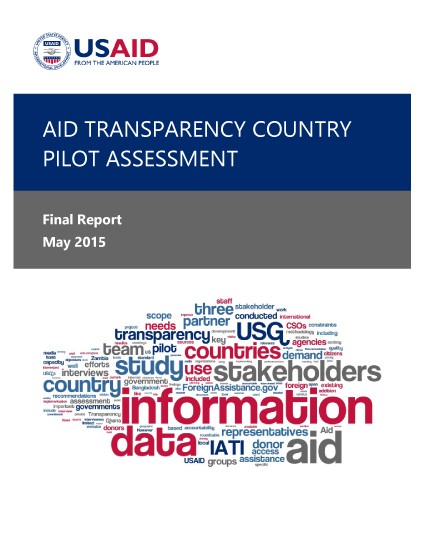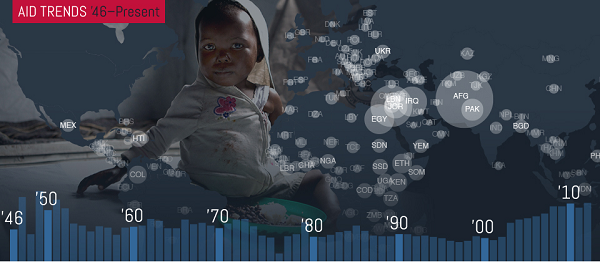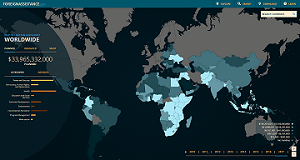USAID is committed to the President's Open Government initiative, upholding the values of transparency, participation, and collaboration in tangible ways that benefit the American people.
Aid Transparency Country Pilot Assessment
To help inform the U.S. Government’s aid transparency agenda, USAID conducted three aid transparency country pilot studies in Zambia (May 2014), Ghana (June 2014), and Bangladesh (September 2014). The country pilots assessed the demand for and relevance of information that the U.S. Government is making available, as well as the capacity of different groups to use it. The final report summarizes findings from the three pilots and provides recommendations to help improve the transmission of foreign assistance data to ensure that the transparency efforts of the U.S. Government create development impact.
USAID's Foreign Aid Explorer
As the lead U.S. Government development agency, USAID is responsible for reporting whole-of-government official foreign assistance data and information to Congress and the Development Assistance Committee (DAC) of the Organisation for Economic Co-operation and Development (OECD) on an annual basis. The report to Congress is called the U.S. Overseas Loans and Grants publication commonly known as the "Greenbook" which provides a complete historical record of all foreign assistance provided by the United States to the rest of the world since 1946. USAID also reports Official Development Assistance (ODA) and Other Official Flows (OOF) to the OECD/DAC on behalf of the U.S. Government each year.
In order to fulfill these reporting requirements and in keeping with USAID's commitment to transparency and the President's Open Government Initiative, USAID maintains a detailed database that powers the Foreign Aid Explorer. The Foreign Aid Explorer shows the multi-dimensional picture of U.S. foreign assistance through a highly visual and interactive website, making it easy for all users to find and retrieve the data they need. For the casual user, there are interactive maps and graphics that display the historical details of U.S. foreign assistance, allowing users to explore foreign aid data across countries, sectors, and over time. More advanced users can quickly download their desired data using our data query tools or by selecting from a choice of prepared files, including those used for Greenbook and OECD/DAC reporting.
International Aid Transparency Initiative (IATI)
USAID plays a leading role in ensuring that the U.S. Government meets its commitments under the International Aid Transparency Initiative (IATI) to publish up-to-date information in a common, open format that makes it easy for stakeholders to find, use and compare with other donors' information about foreign aid spending. In June 2015, USAID released a Cost Management Plan which elaborates on the necessary actions for USAID to further its IATI commitments.
In November 2011, the United States became a signatory to the IATI. IATI is a voluntary, multi-stakeholder initiative that includes donors, partner countries, and civil society organizations whose aim is to make information about foreign aid spending easier to access, use, and understand. Late in 2012, the U.S. Government published its IATI implementation schedule and first IATI-compliant data files, which included a timetable and frequency of data publication and an overview of the types of data to be published. USAID's IATI data is updated quarterly and is accessible on ForeignAssistance.gov, which is the repository for all USG IATI data.
ForeignAssistance.gov
Members of the public can search and visualize detailed, timely information about what, where, how and with whom USAID spends its development dollars. These financial data are available on ForeignAssistance.gov (referred to as FA.gov), which is managed by the Department of State and is the repository for all U.S. Government data on foreign aid. Publication of these data is part of USAID's commitment to increasing our transparency and accountability, and is required by the OMB Bulletin 12-01 [PDF], published in September 2012.
The first release of USAID data on FA.gov in December 2010 consisted of consolidated Department of State and USAID budget and appropriation data from fiscal years 2006–2011, as available in the Congressional Budget Justification. In June 2012, USAID began publishing obligation and disbursement data by operating unit and sector starting from fiscal year 2009. In July 2013, USAID was the first U.S. Government agency to publish detailed, disaggregated data and information at the individual transaction level to FA.gov as required by the OMB Bulletin 12-01 [PDF]. USAID updates this data every quarter and is working to improve the quality and comprehensiveness of its data.
Evaluation
Relevant and high-quality evaluation is an important tool to track the progress, results and effectiveness of international development programs. USAID's evaluation findings are shared as widely as possible, with a commitment to full and active disclosure, per the Evaluation Policy, which sets high standards for ensuring quality, relevance and transparency. Final USAID evaluation reports are available to the public at the Development Experience Clearinghouse. (See also the Performance Reporting page of USAID's website for additional performance and results reporting). To learn more about evaluation at USAID, please visit www.usaid.gov/evaluation.
Open Data and the Development Data Library Explorer
In October 2014, USAID released its first ever open data policy, paving the way to provide the global public with regular, systematic access to USAID-funded data for the first time in the organization's history. The Agency modified all of its awards to stipulate that USAID-funded data must be registered in a central repository, and made publicly available, wherever it could do so responsibly, without violating privacy, security and other legal considerations.
This repository, the Development Data Library (DDL), is found at www.usaid.gov/data. Our hundreds of partners around the world have supplied data on everything from food security in Bangladesh to HIV prevention efforts in Zambia, youth participation in Georgian civil society, and on construction and anti-corruption efforts across the globe. USAID looks forward to upgrading the DDL in the coming year to provide an enhanced user experience for the general public. USAID also looks forward to releasing new datasets that can help advance efforts in support of the Sustainable Development Goals and generate new insight into some of the most intractable challenges in international development.
Country Development Cooperation Strategies (CDCS)
Transparency is also reflected in the development of the Country Development Cooperation Strategies (CDCS). Within two months of a CDCS approval, the USAID Mission prepares a public version that is posted on the Agency's web site. The public version provides the basis for dialogue with Congress, host country partners and other stakeholders in the private sector as the Mission moves forward in project design. In keeping with President Obama's commitment to the relationship between transparency and good governance abroad as well as at home, USAID's foreign assistance programs help countries to be more open and accountable to their stakeholders.










Comment
Make a general inquiry or suggest an improvement.